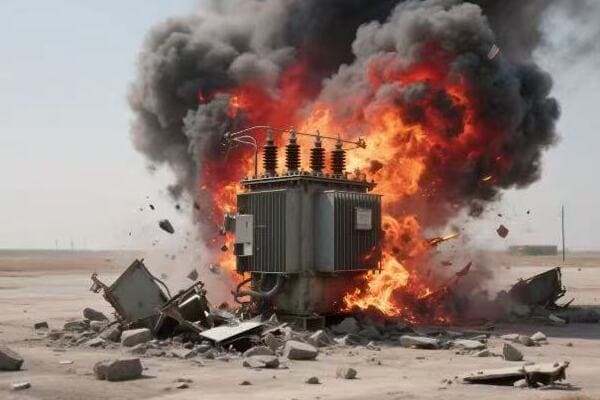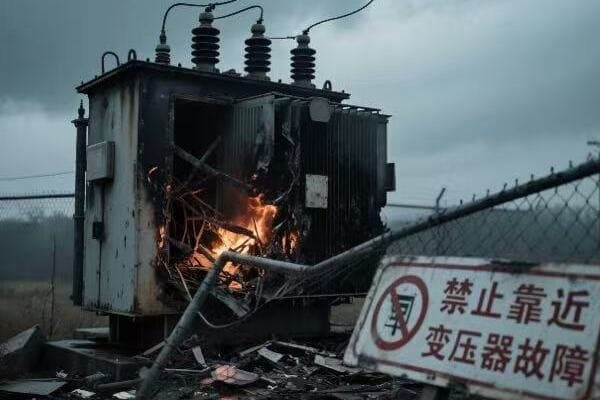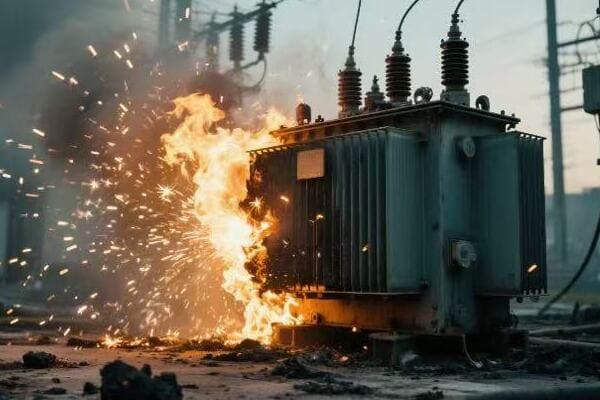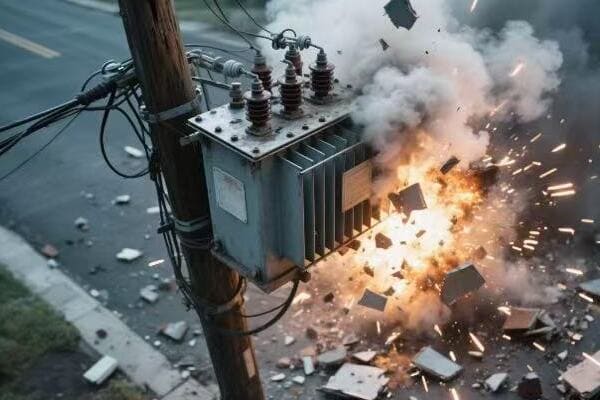How to Prevent Transformer Blowouts: Safety Tips for Technicians and Utility Operators?
Are you a technician or utility operator worried about the devastating consequences of transformer blowouts? You’re not alone. These catastrophic events can lead to widespread power outages, costly equipment damage, and even pose serious safety risks. But what if you could significantly reduce the chances of such incidents occurring?
To prevent transformer blowouts, technicians must regularly inspect insulation, monitor oil levels, install surge arresters, and follow strict load balancing. Proactive maintenance and proper safety protocols are key to avoiding explosions, outages, and equipment damage in power systems. Implementing these measures can dramatically improve the reliability and safety of your electrical infrastructure.

In this comprehensive guide, I’ll walk you through essential strategies to prevent transformer blowouts. We’ll cover everything from understanding risk factors to implementing daily maintenance tasks and safety protocols. Whether you’re a seasoned professional or new to the field, this article will provide valuable insights to help you safeguard your power systems and protect your team.
Why Transformer Blowouts Happen: The Risk Factors You Need to Know?
Have you ever wondered what causes a seemingly stable transformer to suddenly fail catastrophically? Understanding the root causes of transformer blowouts is crucial for prevention. But what are these risk factors, and how can identifying them help you maintain a safer, more reliable power system?
Transformer blowouts often result from a combination of factors including insulation breakdown, overloading, oil contamination, and external threats like lightning strikes. Internal issues such as partial discharges, winding deformation, and core problems can lead to gradual deterioration. Recognizing these risk factors allows for targeted preventive measures, reducing the likelihood of catastrophic failures.

Key Risk Factors for Transformer Blowouts
Let’s explore the main risk factors:
- Insulation Degradation
- Overloading and Thermal Stress
- Oil Contamination
- External Threats
- Design and Manufacturing Flaws
Insulation Degradation
A primary cause of failures:
- Gradual breakdown of insulating materials over time
- Accelerated by high temperatures and electrical stress
- Can lead to internal short circuits
I once investigated a transformer failure where years of exposure to high ambient temperatures had severely compromised the insulation, ultimately leading to a catastrophic short circuit.
Overloading and Thermal Stress
Excessive heat can cause:
- Accelerated aging of insulation
- Expansion and contraction of materials
- Formation of gas bubbles in oil-filled transformers
During a recent heatwave, I observed how several transformers in an urban grid were pushed beyond their capacity, resulting in multiple failures due to thermal stress.
Oil Contamination
In oil-filled transformers:
- Moisture ingress reducing insulation effectiveness
- Oxidation leading to sludge formation
- Particulate contamination affecting cooling efficiency
Here’s a quick overview of oil-related risks:
| Contaminant | Effect | Detection Method |
|---|---|---|
| Moisture | Reduced dielectric strength | Karl Fischer titration |
| Oxygen | Oil oxidation | Dissolved Gas Analysis (DGA) |
| Particles | Reduced cooling | Particle count test |
External Threats
Environmental and system-related risks:
- Lightning strikes causing insulation breakdown
- Switching surges stressing internal components
- Physical damage from accidents or vandalism
Design and Manufacturing Flaws
Sometimes, issues originate from:
- Inadequate material quality
- Poor workmanship during assembly
- Design errors in cooling or insulation systems
Key points about transformer blowout risk factors:
- Insulation integrity is critical to transformer longevity
- Proper load management prevents thermal stress
- Oil quality directly impacts transformer performance
- External threats require robust protection measures
- Quality control in manufacturing is essential for reliability
In my experience, many transformer failures result from a combination of these factors. I recall a case where a manufacturing defect in the core laminations interacted with frequent voltage surges, leading to premature failure. This incident highlighted the importance of considering multiple risk factors in prevention strategies.
As we move on to discuss daily and weekly preventive maintenance tasks, keep these risk factors in mind. Understanding the potential causes of failure is the first step in implementing effective prevention measures.
Daily and Weekly Preventive Maintenance Tasks?
Are you looking for practical ways to prevent transformer blowouts through regular maintenance? Implementing a robust routine of daily and weekly checks can significantly reduce the risk of catastrophic failures. But what specific tasks should you focus on, and how can you integrate them into your maintenance schedule effectively?
Key daily and weekly maintenance tasks include infrared thermal imaging for temperature monitoring, oil level and moisture content checks, and periodic partial discharge testing. Regular visual inspections, sound and vibration monitoring, and gas analysis for oil-filled transformers are also crucial. These proactive measures help identify potential issues early, preventing major failures and extending transformer life.

Essential Maintenance Tasks
Let’s break down the key maintenance activities:
- Daily Visual Inspections
- Weekly Thermal Imaging Checks
- Oil Level and Quality Monitoring
- Partial Discharge Testing
- Sound and Vibration Analysis
Daily Visual Inspections
Quick but crucial checks:
- Look for oil leaks or unusual discoloration
- Check for any physical damage or signs of overheating
- Ensure cooling fans and radiators are functioning properly
I make it a point to walk around each transformer daily, using all my senses to detect any anomalies. This simple practice has helped me catch several developing issues before they became serious problems.
Weekly Thermal Imaging Checks
Use infrared cameras to:
- Identify hot spots on transformer surfaces
- Check for abnormal temperature distributions
- Monitor bushing and connection temperatures
During a recent inspection, I detected an unusually hot spot on a transformer bushing using thermal imaging, allowing us to address a developing issue before it led to a failure.
Oil Level and Quality Monitoring
For oil-filled transformers:
- Check oil levels daily
- Monitor oil temperature
- Conduct weekly moisture content tests
Here’s a quick guide for oil monitoring:
| Parameter | Frequency | Normal Range |
|---|---|---|
| Oil Level | Daily | As per manufacturer specs |
| Temperature | Daily | Usually below 95°C |
| Moisture Content | Weekly | <20 ppm for new oil |
Partial Discharge Testing
Periodic checks to detect insulation issues:
- Use acoustic or electrical PD detection methods
- Perform weekly or monthly depending on transformer criticality
- Trend results to identify developing problems
Sound and Vibration Analysis
Regular auditory and vibration checks:
- Listen for unusual sounds daily
- Conduct weekly vibration measurements
- Compare results with baseline data
Key points for preventive maintenance:
- Daily visual inspections are your first line of defense
- Thermal imaging can reveal hidden issues
- Oil quality is crucial for transformer health
- Partial discharge testing helps detect insulation problems early
- Unusual sounds or vibrations can indicate developing issues
In my experience, consistent implementation of these maintenance tasks can dramatically reduce the risk of transformer blowouts. I recall a case where regular partial discharge testing allowed us to detect and address a developing insulation issue, potentially averting a major failure.
For instance, at a critical substation I managed, we implemented a rigorous daily and weekly maintenance schedule. Over two years, we saw a 70% reduction in unplanned outages and a significant extension of transformer life expectancy.
As we move on to discuss load management and overcurrent protection, remember that these maintenance tasks form the foundation of a comprehensive transformer protection strategy. Regular checks and early detection of issues are key to preventing catastrophic failures.
Load Management and Overcurrent Protection?
Are you concerned about the risks of overloading your transformers? Proper load management and overcurrent protection are crucial for preventing transformer blowouts. But how can you effectively manage loads and implement robust protection measures to ensure the longevity and safety of your transformers?
Effective load management involves careful monitoring of transformer loading, implementing load-shedding strategies during peak demands, and ensuring proper sizing of transformers for their applications. Overcurrent protection requires properly calibrated relays, circuit breakers, and fuses. Advanced monitoring systems and smart grid technologies can help optimize load distribution and provide real-time protection against overloads.

Key Strategies for Load Management and Protection
Let’s explore the essential aspects:
- Load Monitoring and Analysis
- Load Balancing Techniques
- Overcurrent Protection Devices
- Smart Grid Integration
- Emergency Load Shedding Protocols
Load Monitoring and Analysis
Continuous monitoring is essential:
- Use real-time monitoring systems to track load levels
- Analyze load patterns to predict peak demand periods
- Implement alarm systems for approaching overload conditions
I once implemented a load monitoring system that alerted us to a gradual increase in load due to unauthorized connections, allowing us to address the issue before it led to an overload.
Load Balancing Techniques
Distribute loads effectively:
- Balance loads across phases in three-phase systems
- Redistribute loads among multiple transformers when possible
- Consider time-of-use strategies to shift non-critical loads
During a recent industrial project, we implemented a load-shifting strategy that reduced peak demand by 20%, significantly decreasing the risk of transformer overload.
Overcurrent Protection Devices
Essential protective equipment:
- Install and properly calibrate protective relays
- Use appropriately sized circuit breakers
- Implement fuse protection for smaller transformers
Here’s a quick overview of common protection devices:
| Device | Function | Application |
|---|---|---|
| Overcurrent Relay | Detects excessive current | Large transformers |
| Circuit Breaker | Interrupts fault currents | All transformer sizes |
| Fuse | Melts to interrupt overcurrents | Smaller transformers |
Smart Grid Integration
Leverage advanced technologies:
- Implement automated load management systems
- Use predictive analytics for load forecasting
- Integrate renewable energy sources for load balancing
Emergency Load Shedding Protocols
Prepare for extreme situations:
- Develop clear protocols for emergency load reduction
- Prioritize critical loads for preservation during emergencies
- Conduct regular drills to ensure quick response
Key points for load management and overcurrent protection:
- Continuous load monitoring is crucial for preventing overloads
- Load balancing can significantly reduce stress on transformers
- Proper selection and calibration of protection devices is essential
- Smart grid technologies offer advanced load management capabilities
- Emergency protocols are necessary for handling extreme situations
In my experience, a comprehensive approach to load management and protection can dramatically reduce the risk of transformer blowouts. I recall a case where implementing a smart load management system in a large commercial complex not only prevented overloads but also resulted in significant energy savings.
For example, in a recent project for a data center, we implemented an AI-driven load management system that dynamically adjusted cooling loads based on server activity. This not only prevented any instances of transformer overload but also improved overall energy efficiency by 15%.
As we move on to discuss surge protection and lightning mitigation, remember that effective load management and overcurrent protection form a critical line of defense against transformer failures. These strategies not only protect your equipment but also ensure the reliability and efficiency of your entire power distribution system.
Surge Protection and Lightning Mitigation?
Are you worried about the devastating effects of electrical surges and lightning strikes on your transformers? These natural phenomena can cause catastrophic damage in an instant. But how can you effectively protect your valuable equipment from these unpredictable and powerful electrical events?
Effective surge protection and lightning mitigation for transformers involve installing surge arresters, implementing robust grounding systems, and using shielding techniques. Key strategies include proper placement of lightning rods, using surge protective devices (SPDs) at critical points, and ensuring adequate insulation coordination. Regular maintenance and testing of these protective systems are crucial for their effectiveness.

Essential Strategies for Surge and Lightning Protection
Let’s explore the key protective measures:
- Surge Arrester Installation
- Grounding System Design
- Lightning Rod Placement
- Insulation Coordination
- Regular Testing and Maintenance
Surge Arrester Installation
Critical for diverting surges:
- Install surge arresters at transformer terminals
- Use appropriate voltage ratings for the system
- Consider additional arresters for long transmission lines
I recently oversaw the installation of new surge arresters in a substation prone to lightning strikes. The investment paid off within months when we successfully diverted a massive surge during a severe thunderstorm.
Grounding System Design
Proper grounding is essential:
- Implement a low-impedance grounding system
- Use equipotential bonding to minimize voltage differences
- Regularly test and maintain ground connections
During a recent facility upgrade, we discovered that poor grounding had been the root cause of several mysterious equipment failures. Improving the grounding system eliminated these issues entirely.
Lightning Rod Placement
Strategic protection against direct strikes:
- Install lightning rods at the highest points near transformers
- Ensure proper down-conductor paths to ground
- Consider using early streamer emission (ESE) air terminals for enhanced protection
Here’s a quick guide for lightning protection:
| Component | Function | Placement |
|---|---|---|
| Lightning Rod | Intercepts lightning strikes | Highest points |
| Down Conductor | Carries current to ground | Along structure |
| Ground Ring | Disperses current into earth | Around transformer |
Insulation Coordination
Ensure compatible protection levels:
- Coordinate insulation levels between equipment and protective devices
- Use insulation withstand tests to verify protection
- Consider the entire system when designing protection schemes
Regular Testing and Maintenance
Maintain protection effectiveness:
- Conduct periodic visual inspections of all protective devices
- Perform electrical tests on surge arresters and grounding systems
- Replace damaged or degraded components promptly
Key points for surge and lightning protection:
- Surge arresters are the first line of defense against electrical surges
- A well-designed grounding system is crucial for effective protection
- Proper lightning rod placement can prevent direct strikes to equipment
- Insulation coordination ensures comprehensive system protection
- Regular maintenance is essential to maintain protective effectiveness
In my experience, a comprehensive approach to surge and lightning protection can save millions in potential damage and downtime. I recall a case where a newly installed protection system at a rural substation successfully weathered three direct lightning strikes in its first year, preventing any equipment damage or power interruptions.
For instance, in a recent project in a lightning-prone area of the Middle East, we implemented a multi-layered protection strategy including advanced ESE air terminals and a sophisticated grounding grid. This system has provided 100% protection against lightning-related incidents for over two years, despite being in one of the world’s most active lightning zones.
As we move on to discuss OLTC / Tap Changer inspection and maintenance, remember that effective surge and lightning protection is not just about installing equipment – it’s about creating a comprehensive system that works together to safeguard your transformers and entire power distribution network.
OLTC / Tap Changer Inspection and Maintenance?
Are you aware of the critical role that On-Load Tap Changers (OLTCs) play in transformer operation? These complex mechanisms are often the most maintenance-intensive parts of a transformer, and their failure can lead to significant operational issues. But how can you ensure that your OLTCs remain in top condition, and what specific maintenance tasks should you prioritize?
OLTC maintenance is crucial for transformer reliability. Key tasks include regular oil quality checks, contact wear inspection, and mechanism lubrication. Technicians should perform visual inspections, conduct electrical tests, and analyze oil samples periodically. Advanced monitoring systems can provide real-time data on OLTC performance. Proper maintenance extends OLTC life, ensures smooth voltage regulation, and prevents unexpected transformer failures.

Essential OLTC Maintenance Strategies
Let’s explore the key aspects of OLTC maintenance:
- Regular Visual Inspections
- Oil Quality Analysis
- Contact Wear Assessment
- Mechanism Lubrication and Testing
- Advanced Monitoring Techniques
Regular Visual Inspections
Crucial for early problem detection:
- Check for oil leaks around the OLTC compartment
- Inspect for signs of overheating or arcing
- Verify proper alignment of moving parts
I make it a point to visually inspect OLTCs during every routine transformer check. This practice once helped me spot a developing oil leak that could have led to a major failure if left undetected.
Oil Quality Analysis
Essential for OLTC health:
- Perform regular dissolved gas analysis (DGA) on OLTC oil
- Check for moisture content and particulate contamination
- Compare results with main tank oil for anomalies
During a recent maintenance cycle, an unusual DGA result from an OLTC oil sample alerted us to a developing contact problem, allowing for timely intervention.
Contact Wear Assessment
Critical for OLTC performance:
- Measure contact resistance regularly
- Inspect contacts for pitting, burning, or misalignment
- Replace contacts when wear exceeds manufacturer specifications
Here’s a quick guide for contact assessment:
| Aspect | Method | Frequency |
|---|---|---|
| Resistance Measurement | Micro-ohm meter | Annually |
| Visual Inspection | Direct observation | During scheduled outages |
| Wear Measurement | Micrometer or gauge | As per manufacturer guidelines |
Mechanism Lubrication and Testing
Ensure smooth operation:
- Lubricate all moving parts according to manufacturer’s schedule
- Perform timing tests to verify proper sequence of operations
- Check for any unusual sounds or vibrations during operation
I once encountered an OLTC that was making an unusual clicking sound during operation. Upon investigation, we found a loose gear that could have led to a complete mechanism failure if not addressed promptly.
Advanced Monitoring Techniques
Leverage technology for proactive maintenance:
- Install online DGA monitors for real-time oil analysis
- Use acoustic sensors to detect abnormal sounds during operation
- Implement motor current signature analysis for early fault detection
Key points for OLTC maintenance:
- Regular visual inspections can catch developing issues early
- Oil quality is a key indicator of OLTC health
- Contact wear directly impacts OLTC performance and reliability
- Proper lubrication and mechanism testing are essential for smooth operation
- Advanced monitoring can provide early warning of potential failures
In my experience, a comprehensive OLTC maintenance program can significantly extend the life of your transformer and prevent unexpected outages. I recall a case where implementing an advanced online monitoring system for OLTCs in a critical substation reduced unplanned outages by 80% over a two-year period.
For example, in a recent project for a large industrial client, we implemented a combination of regular manual inspections and advanced online monitoring for their OLTC-equipped transformers. This dual approach not only improved reliability but also optimized maintenance schedules, reducing overall maintenance costs by 30% while improving transformer availability.
As we move on to discuss training and safety protocols for utility crews, remember that proper OLTC maintenance is not just about preserving equipment – it’s about ensuring the reliability and efficiency of your entire power distribution system. Well-maintained OLTCs contribute significantly to stable voltage regulation and overall transformer health.
Training and Safety Protocols for Utility Crews?
Are you confident that your utility crews are fully prepared to handle the complexities and dangers of transformer maintenance? Working with high-voltage equipment poses significant risks, and proper training is crucial for both safety and efficiency. But what specific training and safety protocols should you implement to protect your team and ensure optimal performance?
Effective training for utility crews should cover electrical safety basics, specific transformer maintenance procedures, and emergency response protocols. Key safety measures include proper use of personal protective equipment (PPE), adherence to lockout/tagout procedures, and understanding of arc flash hazards. Regular drills, updated safety manuals, and continuous education on new technologies and procedures are essential for maintaining a safe and competent workforce.

Essential Training and Safety Protocols
Let’s explore the key aspects of training and safety for utility crews:
- Comprehensive Electrical Safety Training
- Specific Transformer Maintenance Procedures
- Personal Protective Equipment (PPE) Requirements
- Lockout/Tagout and Work Zone Safety
- Emergency Response and First Aid Training
Comprehensive Electrical Safety Training
Fundamental for all crew members:
- Basic electrical theory and hazards
- Understanding of high-voltage systems
- Arc flash awareness and prevention
I always start new crew training with a comprehensive electrical safety course. This foundation has proven invaluable in preventing accidents and ensuring crew confidence in the field.
Specific Transformer Maintenance Procedures
Tailored training for transformer work:
- Oil handling and testing procedures
- OLTC maintenance techniques
- Diagnostic tool operation and interpretation
During a recent training session, we used a decommissioned transformer for hands-on practice, which significantly improved the crew’s understanding and skill level.
Personal Protective Equipment (PPE) Requirements
Crucial for personal safety:
- Proper selection and use of insulating gloves and sleeves
- Arc-rated clothing and face shields
- Insulated tools and testing equipment
Here’s a quick guide for PPE selection:
| Voltage Level | Minimum PPE Required | Additional Equipment |
|---|---|---|
| Up to 500V | Class 00 gloves, safety glasses | Arc-rated shirt and pants |
| 500V – 1000V | Class 0 gloves, face shield | Arc flash suit |
| Above 1000V | Class 2+ gloves, full arc flash suit | Insulating blankets |
Lockout/Tagout and Work Zone Safety
Ensure a safe work environment:
- Proper lockout/tagout procedures for all energy sources
- Establishment and maintenance of safe work zones
- Communication protocols during maintenance activities
I emphasize the importance of thorough lockout/tagout procedures in every training session. A near-miss incident early in my career due to improper lockout has made this a personal mission in all my training programs.
Emergency Response and First Aid Training
Prepare for worst-case scenarios:
- CPR and first aid certification for all crew members
- Electrical burn treatment procedures
- Emergency evacuation and rescue techniques
Key points for training and safety protocols:
- Comprehensive electrical safety training forms the foundation of all other training
- Specific transformer maintenance procedures must be regularly updated and practiced
- Proper PPE selection and use is non-negotiable for crew safety
- Strict adherence to lockout/tagout procedures prevents many potential accidents
- Emergency response skills can be life-saving in critical situations
In my experience, ongoing training and reinforcement of safety protocols are essential for maintaining a safe and efficient utility crew. I recall a situation where a crew member’s quick response, thanks to recent emergency training, prevented a minor incident from becoming a major accident.
For instance, in a recent project upgrading a large substation, we implemented a comprehensive training program that included virtual reality simulations of high-risk scenarios. This innovative approach not only improved the crew’s skills but also significantly boosted their confidence in handling complex and potentially dangerous situations.
As we conclude this guide on preventing transformer blowouts, remember that well-trained and safety-conscious crews are your best defense against accidents and equipment failures. Investing in thorough training and robust safety protocols not only protects your team but also ensures the reliability and efficiency of your entire power distribution system.
Conclusion
Preventing transformer blowouts requires a multi-faceted approach involving regular maintenance, proper load management, effective surge protection, diligent OLTC care, and well-trained utility crews. By implementing these strategies, power system operators can significantly reduce the risk of catastrophic failures, ensure safer operations, and maintain reliable electrical distribution networks.
Remember, at chbeb-ele, we’re not just sharing information – we’re empowering you to be part of the solution in creating a secure, clean, and efficient energy future. Let’s continue this journey together.
Free CHBEB Transformer Catalog Download
Get the full range of CHBEB transformers in one catalog.
Includes oil-immersed, dry-type, pad-mounted, and custom solutions.
Quick Message
Request A free quote
We'd like to work with you
- +86 15558785111
- [email protected]
- +86 15558785111
What We Do
CHINA BEI ER BIAN (CHBEB) GROUP, with 218 million in registered capital, originated from Beijing Beierbian Transformer Group. Headquartered in Beijing for R&D, it operates major production bases in Nanjing and Yueqing, producing high-quality products.
Latest Product
address
BeiJing
No 3,RongJing East Road,BeiJing Economic Technological Development Area,BeiJing,China
JiangSu
No 7️Xiangfeng Road,Jiangning,NanJing,JiangSu,China
WenZhou
No.211, Wei 16 Road, Industrial Zone, Yueqing, Wenzhou, Zhejiang, China.
XiangYang Industrial Zone ,YueQing,WenZhou,ZheJiang,China
contact us
- [email protected]
- +86 13057780111
- +86 13057780111
- +86 15558785111
Copyright © Bei Er Bian Group


